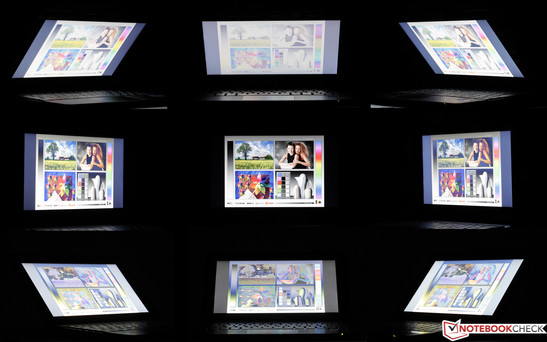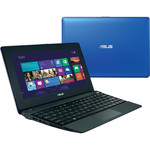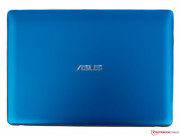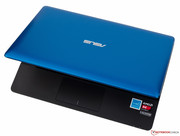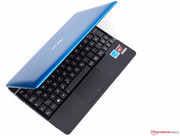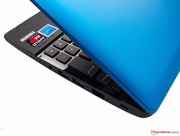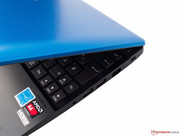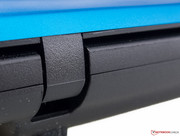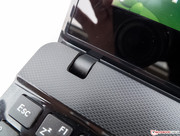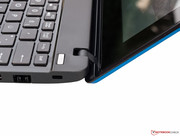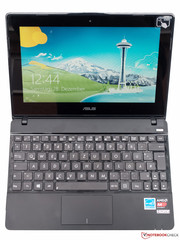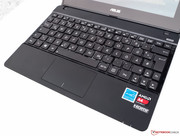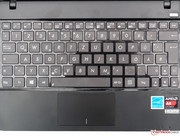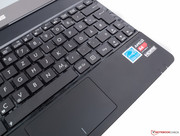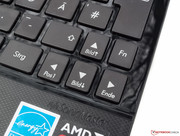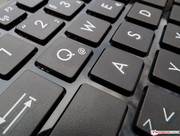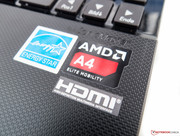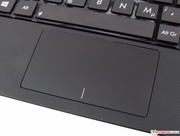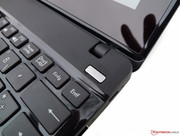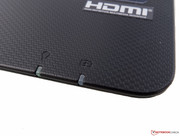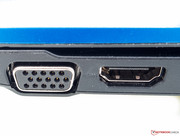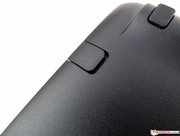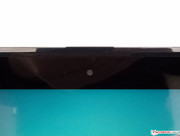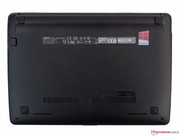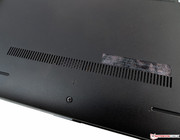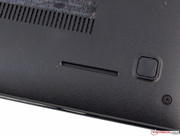Review Asus F102BA-DF047H Netbook

For the original German review, see here.
"Tablet killed the Netbook Star": The downtrend of the mini-laptop positioned in the lowest price range of around 300 Euros (~$407) reached its low in March 2013 in Germany with only 190,000 units sold according to Bitcom/EITO. This is ten times less than in 2009, which was the most successful year where almost two million devices were sold. Sales in Germany were even almost 15 times higher than today due to the higher price at the time.
Nowadays most buyers opt for a tablet with or without a separate keyboard when a small, portable, and affordable computer is needed. While Google's Android has not yet quite found a place in the office world, and is only suitable for productive use to an extent, the first Windows tablets like Toshiba's Encore (8-inch) are closing in on netbooks in terms of price.
So what are the arguments for the affordable, but also sluggish 10-inch laptops? Essentially, they feature the better keyboard compared with tablet docking solutions, and particularly the connectivity that is innately sparse in flat tablets.
We used the Medion Akoya E1317T, which is largely identical in terms of configuration and price, as well as technically, and the Intel-hardware based Asus Transformer Book T100TA-C1-GR convertible (Intel Atom Z3740, 4x 1.33 to 1.86 GHz, 4 watt TDP) with an SSD and IPS screen for approximately 400 Euros (~$543) for comparison.
Our test report shows the possible application fields for the limited power of our review sample, and where it is positioned compared to the competition.
Case
The all over plastic casing only features a matte display bezel and keyboard bed. The rest of the base unit has a dotted texture; the underside is slightly structured and slip-proof. The only surface that is not black is the display's back, which features a matte, shiny blue color. Models of the X102BA series are also available in white, black, and red.
All surfaces are susceptible to fingerprints. The base unit can only be warped marginally even when higher force is used. Overall, the casing makes a stiff, though not necessarily high-quality impression. We did not notice any unpleasantly sharp edges on the casing while working with Asus' F102BA. The display's back has to be dented with quite high pressure to produce image distortions on the front.
We would have appreciated an opening angle of up to 180 degrees for the netbook, particularly in view of its touchscreen. Regrettably, approximately 135 degrees is the maximum. Consequently, even touching the screen only lightly lets the base lift in the front, which is extremely annoying. The hinges largely prevent distracting wobbling when in motion. The lid cannot be opened with one hand. The review netbook's weight of 1.1 kg is roughly on par with the Transformer Book while the Medion weighs 250 g more.
Connectivity
Standard-sized VGA, HDMI, 3 USB ports, audio, and Ethernet will hardly be found on a tablet. But they are on this kind of netbook. Asus tried to position the interfaces far back, which was likely the only possibility due to the base that tapers to the front. This has an advantage when using an external mouse.
Medion's E1317T sports the same ports, but they are located further front. The Transformer Book's array is very slimmed down in comparison, and most ports are only micro-sized.
The power socket's position on the review sample is unfavorable because it is between the HDMI and USB 3.0 port, and gets in the way there. The HDMI port supports Full HD, and the transfer speed of a hard drive connected via USB 3.0 was a bit lower than that measured in other devices.
Communication
The review sample transmits in Wi-Fi standard IEEE 802.11 b/g/n, and supports Bluetooth 4.0 according to Asus. We cannot confirm this because we could not access this feature over the operating system, or better said could not find it at all.
Accessories
Only the netbook, power supply, warranty documents, a piece of paper titled "Owner's Manual", and a license for "Windows 8 Small Screen Touch w/ Office Home & Student 2013" are included in the delivery.
Maintenance
No cover, no maintenance. We did not try whether this changes when the screws on the casing are removed. Omitted maintenance covers, and non-removable batteries always lead to deductions.
Input Devices
Keyboard
Asus designed the layout of the unlit keyboard as closely as possible to the standard. The keys' distribution on the limited surface is appealing. The keys are level, slightly roughened, and feature a short drop, a clearly palpable pressure point, and a firm stroke. That should satisfy most prolific typists. However, the keyboard makes a cheap impression due to its glossy, and difficult to clean keyboard bed as well as the fact that the keyboard can be easily dented over its entire middle. This is even noticed evidently during normal typing.
Touchpad
The sleek ClickPad does not have mechanically dedicated mouse keys, and can only be pressed as a whole. It is too small due to the netbook's size. The tester would have preferred a roughened surface for feedback reasons. The keys' medium resistance is ideal subjectively, and the feedback is clearly perceived both mechanically and audibly. There are not many options for configuring gestures with up to three fingers simultaneously. Unfortunately, occasional lags impair the use. For example, particularly opening a program via double-clicking rarely worked.
Touchscreen
The touchscreen does not always respond to touches immediately either. This might be due to a delayed command execution on the APU's side. The accuracy is good, and it can be used confidently after a bit of familiarization. According to the manufacturer, the screen detects up to ten touch points at the same time.
The WSXGA resolution of 1366x768 pixels (16:9) that the Asus F102BA series has in common with both comparison devices is acceptable considering the screen's small size. It results in a pixel density of 155 ppi. A higher resolution would make elements on the desktop too small to use with a finger. It only gets tricky in the task bar (and, of course, in various programs not optimized for touch).
A screen based on TN technology alongside its usual drawbacks in terms of color reproduction, contrast, and viewing angle stability is installed. As typical in this price-range, and for touchscreens anyway, the surface is reflective though it is fairly moderate. The screen is definitely too dark with an average brightness of only 217 cd/m²; at least 250 cd/m² would have been welcomed. The Transformer Book almost achieves this rate, and the Medion device is virtually on par with the review sample. The illumination is satisfactory.
| |||||||||||||||||||||||||
Brightness Distribution: 90 %
Center on Battery: 217 cd/m²
Contrast: 226:1 (Black: 0.96 cd/m²)
ΔE ColorChecker Calman: 4.19 | ∀{0.5-29.43 Ø4.77}
ΔE Greyscale Calman: 3.34 | ∀{0.09-98 Ø5}
37.6% AdobeRGB 1998 (Argyll 1.6.3 3D)
40.98% AdobeRGB 1998 (Argyll 3D)
59.2% sRGB (Argyll 3D)
39.67% Display P3 (Argyll 3D)
Gamma: 2.23
CCT: 7239 K
The black level is extremely high with not less than 0.96 cd/m². This adds up to a contrast of just 226:1. However, the subjective impression is not quite that bad when coincidentally looking at the screen from the ideal angle. The comparison devices score much better; Medion: 0.5 cd/m² and 424:1, and Asus' Transformer Book (IPS): 0.24 cd/m² and 1033:1.
The image sharpness is inconspicuous. The screen covers almost 38% of the AdobeRGB color space, which is a common rate for a TN screen. Users, who need more for (semi) professional image editing or the like, should opt for a device with an IPS or MVA screen. Fortunately, the color reproduction is exceptionally accurate. The average DeltaE 2000 rate of just 4 is truly impressive. The bluish cast common in most low-budget TN screens is only marginal here, and barely visible to the naked eye.
Although the screen is reflective, this quality is not very marked. Owing to this fact, it is possible to work perfectly with the netbook outdoors on a cloudy day when no light source shines directly on the screen. The weather conditions did not allow testing in direct sunlight, but experience has shown that even matte, and much brighter screens are no longer legible.
The installed screen cannot be called viewing angle stable. The known inverting effect sets in quite soon, particularly when viewing the screen from below. The usual losses in contrast with a milky image impression occur when looking down on the screen. Views from the side prove to be relatively (!) lenient; obvious distortions are actually first noticed starting at angles of 45 degrees or more. We have seen worse outcomes.
Performance
As for performance, things get a bit uncomfortable here. The term does not really fit to what Asus presents. AMD's APU is dubbed A4-1200 (2x 1.0 GHz, AMD Radeon HD 8180 GPU, TDP: 4 watts), and its processing power is bottom of the barrel compared with that which new devices can offer. The too small working memory of just 2 GB single-channel RAM (1066 MHz) ultimately pulls the brake as it repeatedly forces the initially weak system to access the page file, which slows it down even more. The included Microsoft Office license suggests that Asus' netbook should mainly be used as a typewriter. Its performance is enough for that purpose.
Processor
AMD's A4-1200 APU only clocks with 1 GHz, and does not feature a Turbo. It is a known fact that AMD processors now have, and have had for some time, a lower per MHz performance than Intel's CPUs. Thus, we have a combination of only two cores with a low per MHz performance fused with a very low clock. The result is as expected. The review sample's APU is at the lowest end of the scores achieved by all tested laptops and netbooks in both Cinebench R10 and R11.5 that we use to assess the pure CPU performance of one or both cores during load. Besides a few other devices with the same APU, essentially only AMD's C-70, C-60, C-50, and an A4-1250 APU gather at the bottom end of performance. Thus, the A4-1200 is (more or less) suitable for small devices like netbooks and tablets, where power is allegedly not important, but primarily the lowest possible consumption.
The results of our Medion, powered by the same APU, are on par. In comparison, the Transformer Book has a lead of 11% to 204% depending on the benchmark, which is due to its stronger Intel Atom Z3740 CPU that, by the way, features four cores with a clock ranging from 1.33 to 1.86 GHz - and that with a TDP of just 4 watts. Our review sample did not get slower in battery mode.
| Cinebench R10 | |
| Rendering Multiple CPUs 32Bit (sort by value) | |
| Asus F102BA-DF047H | |
| Medion Akoya E1317T | |
| Asus Transformer Book T100TA-C1-GR | |
| Lenovo IdeaTab Miix 10 64GB | |
| Rendering Single 32Bit (sort by value) | |
| Asus F102BA-DF047H | |
| Medion Akoya E1317T | |
| Asus Transformer Book T100TA-C1-GR | |
| Lenovo IdeaTab Miix 10 64GB | |
| Rendering Multiple CPUs 64Bit (sort by value) | |
| Asus F102BA-DF047H | |
| Medion Akoya E1317T | |
| Rendering Single CPUs 64Bit (sort by value) | |
| Asus F102BA-DF047H | |
| Medion Akoya E1317T | |
| Cinebench R11.5 | |
| CPU Multi 64Bit (sort by value) | |
| Asus F102BA-DF047H | |
| Medion Akoya E1317T | |
| CPU Single 64Bit (sort by value) | |
| Asus F102BA-DF047H | |
| Medion Akoya E1317T | |
System Performance
PCMark 7, used for assessing the system performance, confirmed the APU's disappointing presentation in the CPU test. Our sample is one of the slowest devices in our entire database in the Productivity benchmark. Asus' Transformer Book T100TA clearly takes a lead with 104% to 213% more speed. Even identically equipped devices like Toshiba's W30 achieve an approximately 10% better score.
| Asus F102BA-DF047H Radeon HD 8180, A4-1200, Hitachi Travelstar Z5K500 HTS545032A7E680 | Medion Akoya E1317T Radeon HD 8180, A4-1200, Hitachi Travelstar Z5K500 HTS545050A7E680 | Asus Transformer Book T100TA-C1-GR HD Graphics (Bay Trail), Z3740, 32 GB eMMC Flash | Lenovo IdeaTab Miix 10 64GB SGX545, Z2760, 64 GB SSD | |
|---|---|---|---|---|
| PCMark 7 | 4% | 149% | 78% | |
| Score (Points) | 927 | 1012 9% | 2339 152% | 1413 52% |
| Lightweight (Points) | 617 | 627 2% | 1258 104% | 941 53% |
| Productivity (Points) | 314 | 324 3% | 983 213% | 600 91% |
| System Storage (Points) | 1439 | 1470 2% | 3255 126% | 3094 115% |
| PCMark 7 Score | 927 points | |
Help | ||
Storage Device
Hitachi's Travelstar Z5K500 HTS545032A7E680 hard drive is not impressive either. The sequential read transfer rate of just 81 MB/s (CrystalDiskMark 3.0) and 60 MB/s (HD Tune) is no longer contemporary. It can be excluded that the HDD is slowed down by the APU when compared with the much better results of Medion's netbook. The CPU's load during HDD operation is remarkable. Rates of approximately 10% again show how low-performance the A4-1200 is. Asus' Transformer Book T100TA-C1-GR benefits from its SSD particularly when reading small random data blocks (Read 4K).
Graphics Card
AMD's Radeon HD 8180 GPU in Asus' F102BA does not meet expectations in the 3DMark benchmark test. Comparably equipped devices, such as Toshiba's W30 or even Medion' E1317T, clearly lead with +35%. Overall, the netbook only presents the graphics performance level of an Adreno 320 graphics unit, which is used in many ARM-based smartphones and tablets. Intel's integrated HD 4000 graphics unit (Ivy Bridge) can reap in an approximately twice as high score here.
At least our review sample rendered 1080p videos on its own screen and in Full HD resolution on a TV smoothly with the right player and enabled hardware accelerator (tested with VLC).
| 3DMark Ice Storm Standard Score | 8967 points | |
Help | ||
Gaming Performance
Generally, the platform cannot render older, and less demanding games either. According to our experience, only age-old titles from around the new millennium, such as System Shock II (59 fps @ 1366x768, Toshiba Satellite W30D-A-100, same APU), Diablo, or Fallout should run lag-free. Of course Solitaire, Minesweeper, etc. are no problem.
| 3DMark | |
| 1280x720 Ice Storm Standard Score (sort by value) | |
| Asus F102BA-DF047H | |
| Medion Akoya E1317T | |
| Asus Transformer Book T100TA-C1-GR | |
| 1280x720 Ice Storm Standard Graphics (sort by value) | |
| Asus F102BA-DF047H | |
| Medion Akoya E1317T | |
| Asus Transformer Book T100TA-C1-GR | |
| 1280x720 Ice Storm Standard Physics (sort by value) | |
| Asus F102BA-DF047H | |
| Medion Akoya E1317T | |
| Asus Transformer Book T100TA-C1-GR | |
| low | med. | high | ultra | |
|---|---|---|---|---|
| Diablo III (2012) | 16.86 | |||
| Tomb Raider (2013) | 13.2 | |||
| Dota 2 (2013) | 6.04 |
Emissions
System Noise
The other side of the low performance is whisper-quiet operation. There is no idle mode in the actual sense because even the most basic tasks already fully load the APU. The fan can just be discerned from the background noises during longer full load at a normal seating distance to the device. The HDD is occasionally audible with quiet click noises.
Noise level
| Idle |
| 30.7 / 30.7 / 30.7 dB(A) |
| HDD |
| 31.2 dB(A) |
| Load |
| 31.6 / 37.2 dB(A) |
 | ||
30 dB silent 40 dB(A) audible 50 dB(A) loud |
||
min: | ||
Temperature
The netbook's temperature on the upper side did not get noticeably warm; not even after an hour of Prime95 + Furmark. The only spot that got warmer than body temperature was on the underside, and can be seen in the screenshot below (max. load). The main vent is on the side so that the cooling is not impaired when using the netbook on the lap.
The APU reached a temperature of up to 79 °C; throttling was not observed.
(+) The maximum temperature on the upper side is 36.6 °C / 98 F, compared to the average of 33.1 °C / 92 F, ranging from 21.6 to 53.2 °C for the class Netbook.
(±) The bottom heats up to a maximum of 40.4 °C / 105 F, compared to the average of 36.6 °C / 98 F
(+) In idle usage, the average temperature for the upper side is 25.2 °C / 77 F, compared to the device average of 29.8 °C / 86 F.
(+) The palmrests and touchpad are cooler than skin temperature with a maximum of 30.6 °C / 87.1 F and are therefore cool to the touch.
(±) The average temperature of the palmrest area of similar devices was 29.3 °C / 84.7 F (-1.3 °C / -2.4 F).
Speakers
Considering that both front-positioned, downward speakers only look like two small slits, their audio output is still tolerable, fairly balanced when placed on a solid surface and maximum volumes are not used. Then the size-related limits of the small speakers become very evident. The overemphasized mids and trebles quickly start to screech, and the volume level fluctuates. Instruments can usually be discerned; it only gets difficult in low-ranges because there is absolutely no bass. The volume is high enough to fill a 25 m² room with sound. Compared with a full-blown system, the Realtek on-board sound does a good job.
Energy Management
Power Consumption
Power consumption in a turned off state is no longer appropriate. The review sample unfortunately still drained 0.1 watts from the outlet then. However, 0.2 watts in standby is acceptable. Our Asus netbook lines in among the most economic models of its category in the alleged idle mode; it is also still in the upper third of the field during load. The 33 watt power supply is strong enough in view of the maximum power consumption of 13.7 watts that we ascertained.
| Off / Standby | |
| Idle | |
| Load |
|
Key:
min: | |
Battery Runtime
Four and a half hours in the Wi-Fi test sounds good at first - until the user realizes that the APU only has a TDP of 4 watts. The low performance is thus not justified by an exceptionally good battery runtime. The netbook is not so lightweight that a reduced weight could be made responsible for that either.
The differences to the Medion can again be neglected; however, our Transformer Book clearly takes the lead in the comparison with the three devices. Compared with the Asus, its advantage is 42% during load and a high 136% in the Wi-Fi runtime test where it lasted for almost eleven hours.
Verdict
Asus, that was a nice try. The Taiwanese manufacturer obviously wants to lure the last potential netbook buyers, but ultimately only impressively proves that this device category is rightly close to extinction. Disregarding interfaces, keyboard, touchscreen, and price, using the Asus F102BA-DF047H proved to be anguishing most of the time. Every activity that went beyond using undemanding, and particularly opened programs, pushed the netbook to its performance limits. Even browsing was tedious because the device sometimes needed several seconds to build up more sophisticated sites (Flash, etc.).
The few good sides, like the suitability as a portable HD video player, that we found in the test completely faded into the background in the author's opinion. Perhaps the system could be sped up a bit by installing an SSD, but that would be proverbially casting pearls before swine.
The Asus F102BA is currently sold for approximately 320 Euros (~$434). We would recommend investing 100 Euros (~$135) more, and looking for alternatives in this price range. For example, Lenovo's Edge E145 would be an option when focus is on office applications; Asus' Transformer Book T100TA offers a considerable added value in terms of touch-inputting and portability owing to its detachable solution. Both alternatives are much superior to the F102BA also regarding performance.









